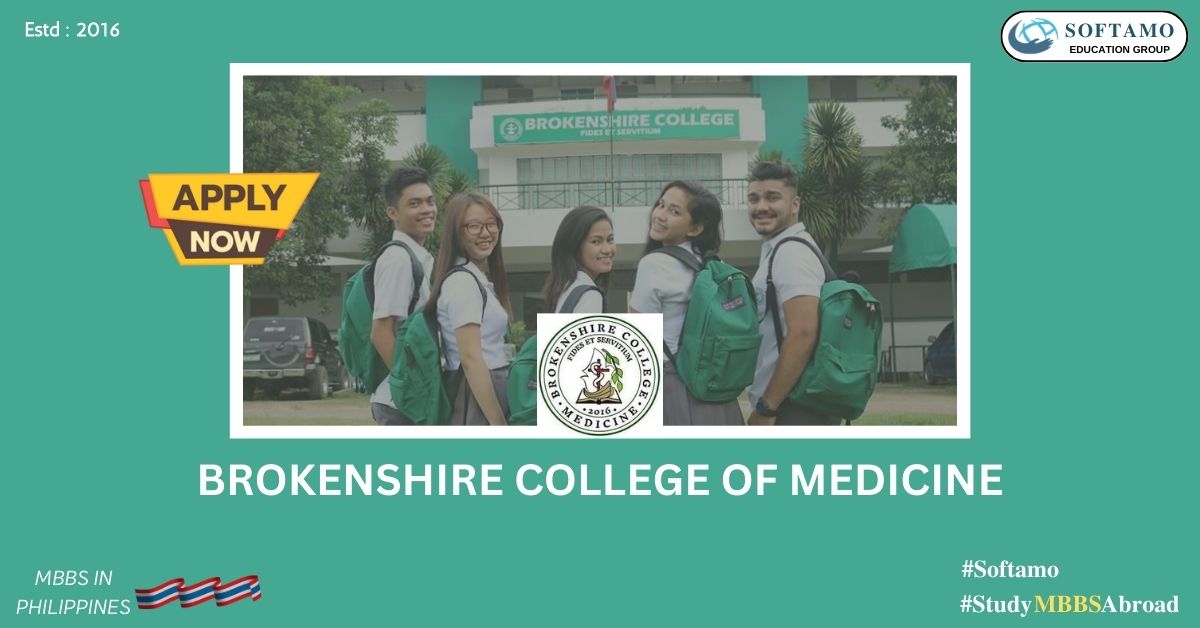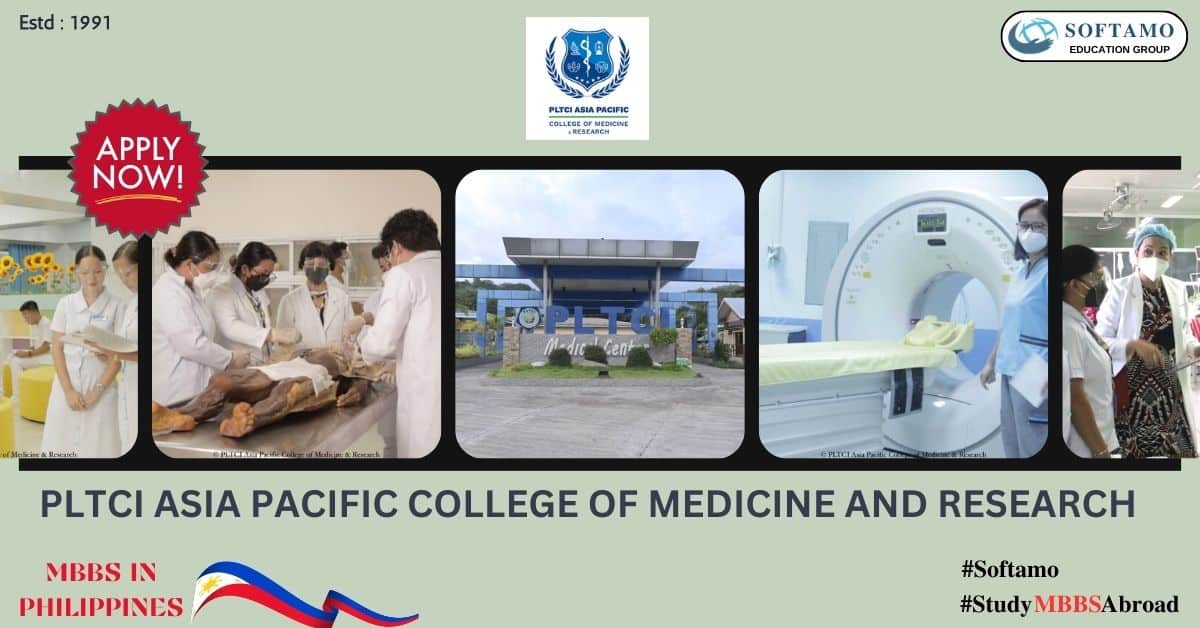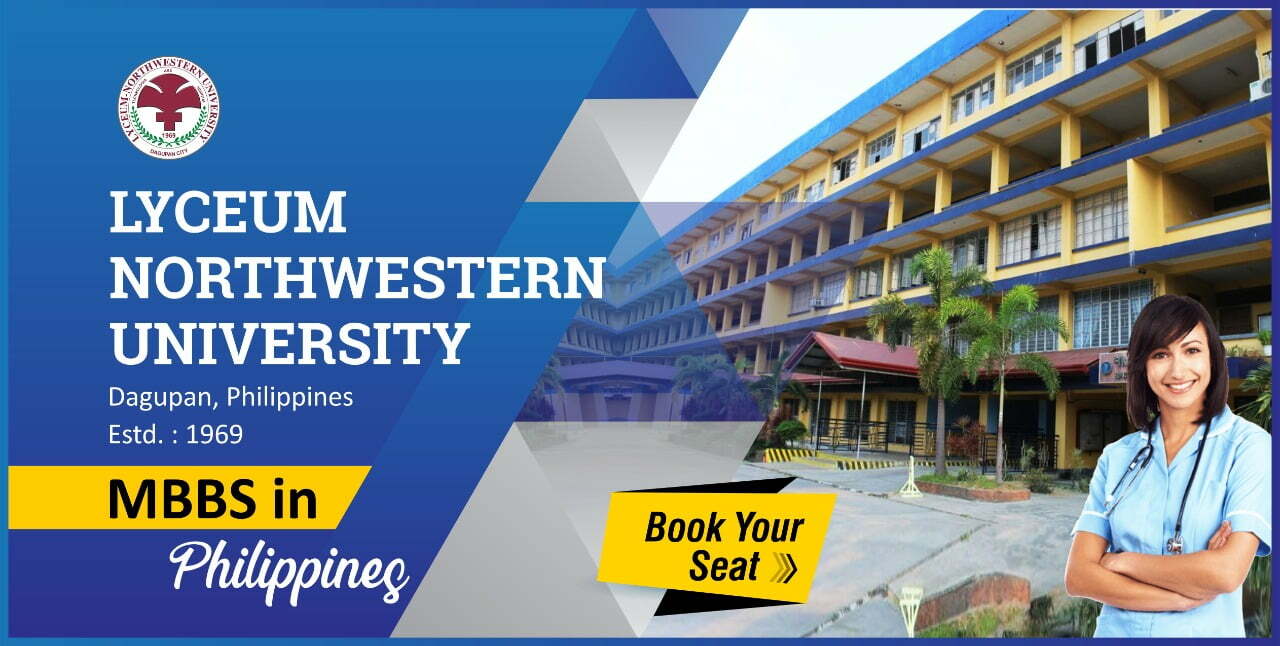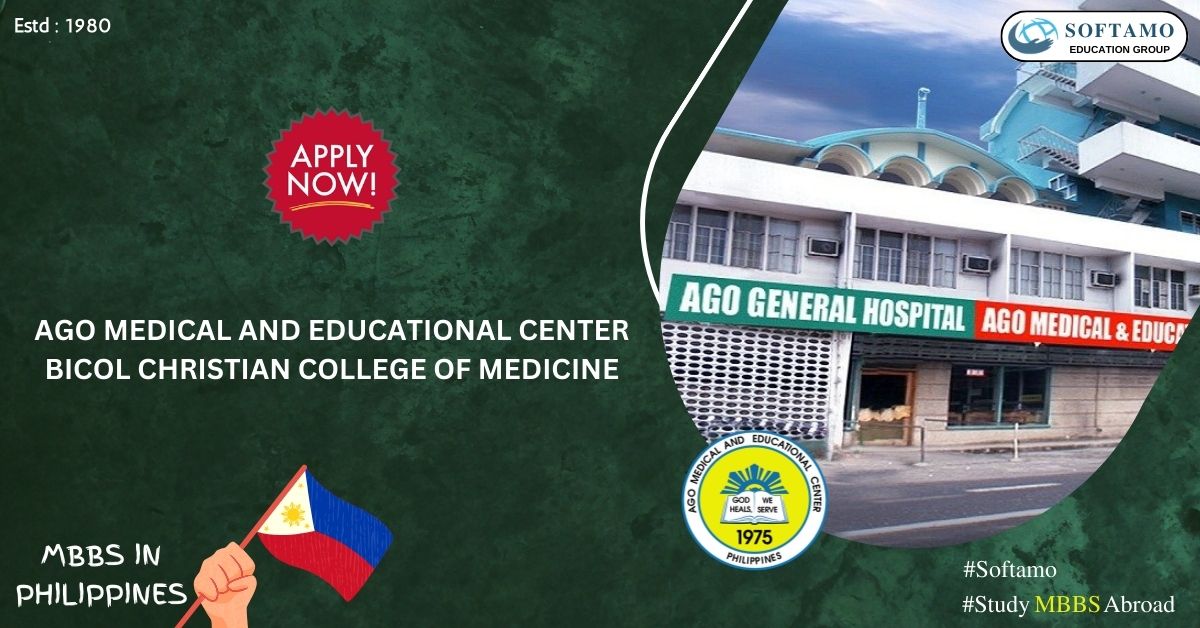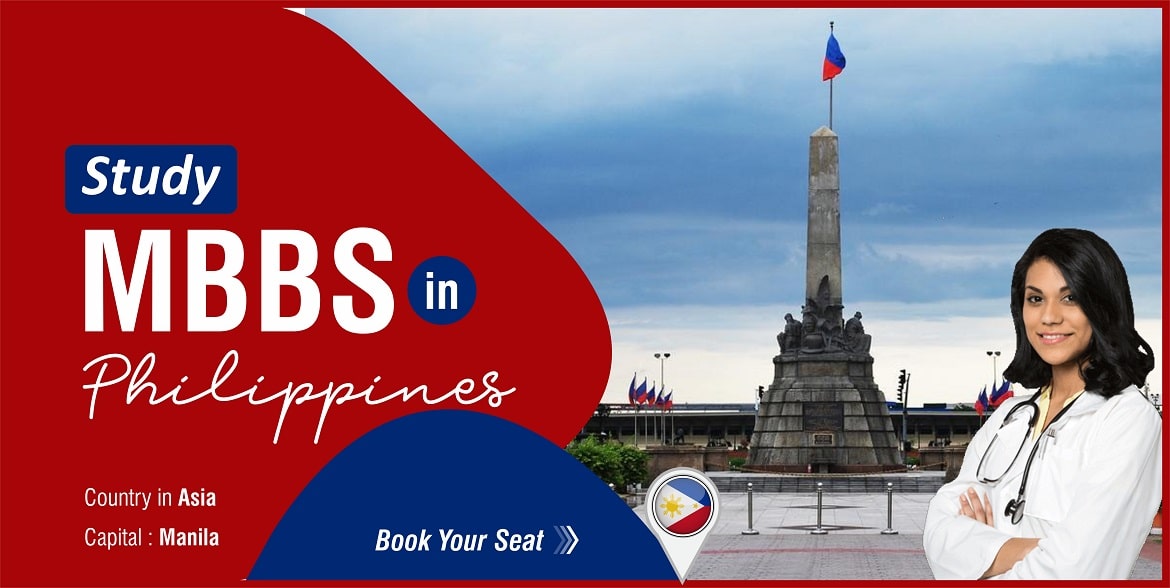
More than 10,000 international students select the Philippines as their destination to pursue MBBS. The majority of medical universities in the Philippines adhere to the American Standard Medical Education, which simplifies preparation for the USMLE and Foreign Medical Graduates Exam (FMGE) for students. With globally recognized medical degrees, the Philippines is an excellent place to study MBBS. Students who choose to study MBBS in the Philippines will feel at ease due to the warm and hospitable nature of the Filipino people. Additionally, the Philippines is a secure country and ensures accommodations for all MBBS students. Compared to other countries, the Philippines offers MBBS courses at genuine and reasonable rates, making it an attractive option for Indian students.
About the Philippines
The Philippines is a Southeast Asian country composed of over 7,600 islands located in the western Pacific Ocean. Its capital city is Manila, and it has a population of over 109 million people. The country’s diverse culture, rich history, natural wonders, and warm hospitality make it a popular tourist destination.
The Philippines was named after King Philip II of Spain, who colonized the country in the 16th century. Spanish influence is evident in the country’s language, architecture, and cuisine. The Philippines gained independence from the United States in 1946 and has since become a republic.
Quick Contact
The country has a tropical climate, with two distinct seasons: the wet season, which lasts from May to October, and the dry season, which lasts from November to April. The Philippines is known for its natural beauty, including its beaches, coral reefs, and lush forests. Some of the most popular tourist destinations in the country include Boracay Island, Palawan Island, and the Chocolate Hills in Bohol.
The Philippines is also home to many cultural and historical landmarks. The city of Vigan, located in the northern part of the country, is a UNESCO World Heritage Site known for its well-preserved Spanish colonial architecture. The walled city of Intramuros in Manila is another popular destination, known for its historical significance and beautiful architecture. The country also has many museums and art galleries, including the National Museum of the Philippines, which houses a collection of artifacts and artwork that showcase the country’s rich cultural heritage.
The Philippines is a melting pot of different cultures, with influences from Spain, China, Malaysia, and other neighboring countries. Filipino cuisine is a reflection of this diversity, with dishes ranging from adobo (a popular meat dish marinated in soy sauce and vinegar) to pancit (a noodle dish with various toppings) and sinigang (a sour soup made with meat or seafood and vegetables). The country is also known for its street food, which includes skewered meat, grilled fish, and various types of fried snacks.
The Philippines is a predominantly Catholic country, with a significant Muslim population in the southern part of the country. The country has a rich tradition of festivals and celebrations, with many events being held throughout the year. Some of the most popular festivals include the Ati-Atihan Festival in Aklan, the Sinulog Festival in Cebu, and the MassKara Festival in Bacolod.
The economy of the Philippines has been growing steadily in recent years, with a focus on the service and manufacturing industries. The country is also a major exporter of agricultural products, including rice, bananas, and coconuts. Remittances from overseas Filipino workers are also a significant contributor to the country’s economy.
However, the Philippines also faces various challenges, including poverty, corruption, and political instability. The government has been taking steps to address these issues, including implementing social welfare programs and anti-corruption measures.
Why Study MBBS in Philippines for Indian Students?
- Affordable education Philippines medical universities offer some of the most affordable and lowest tuition fee structures in the world. This makes it a highly attractive option for students who are looking for quality education but are also budget-conscious.
- American-style PBL curriculum The Philippines follows the American-style Problem-Based Learning (PBL) curriculum, which is known for its highly practical and hands-on approach to learning. This type of education emphasizes teamwork, critical thinking, and problem-solving skills, which are highly valued in the medical profession.
- English as the medium of instruction The medium of instruction in the Philippines is English, making it an ideal destination for international students, including those from India. This eliminates the need for students to learn a new language, allowing them to focus on their studies.
- High literacy rate The Philippines has an impressive literacy rate of over 93%. This means that education is highly valued and the population is well-educated. This has a positive impact on the quality of education provided by the universities.
- No donations are required In contrast to many medical universities in India, there is no requirement for students to pay donations or capitation fees to secure a seat in a medical university in the Philippines. This provides a level playing field for all students, regardless of their financial status.
- Skilled English speakers The Philippines is the most significant English-speaking country in Asia and the third-largest English-speaking country in the world. This means that the people are highly proficient in English, which is the medium of instruction for higher education. This gives students an added advantage when it comes to communicating in English, which is the universal language of medicine.
- High-quality education The Philippines is known for providing high-quality education in various fields, including medicine. The medical universities in the country are well-equipped with modern facilities and state-of-the-art technology, ensuring that students receive the best possible education.
- Easy adaptation to the culture The way of life in the Philippines is quite simple to adapt to, particularly for Indian students. The people are warm and friendly, making it easy for students to make friends and feel at home. The climate is also similar to that of India, with temperatures ranging between 28 to 32 degrees Celsius throughout the year.
- Female-friendly environment The Philippines is a female-dominated country, and as a result, it is considered one of the safest places in Asia for women. Female students who choose to study in the Philippines can feel secure and confident in their surroundings, which is essential for a successful academic experience.
- Recognized by the Medical Council of India The Medical Council of India recognizes the M.D. course in medicine from the Philippines as being equivalent to MBBS in India. This means that students who complete their medical education in the Philippines can practice medicine in India after passing the necessary licensing exams.
MBBS in Philippines Overview
MBBS in Philippines for Indian Students
For medical aspirants all over the world, Philippines has become a popular destination to pursue MBBS. If you are an Indian student and are contemplating studying MBBS in the Philippines, this article will provide you with all the information you need to make an informed decision.
Located in Asia, Philippines offers courses in English, making it easier for international students to learn and communicate. In addition, it provides a rich cultural experience that goes beyond just academics. The country is home to some of the best medical colleges in the world, offering MBBS courses at a cost ranging from 15 to 22 lakhs for a duration of five years.
The MBBS degrees provided by the colleges in the Philippines are approved and recognized by both the World Health Organization (WHO) and the Medical Council of India (MCI). The high success rate of students who appear for the United States Medical Licensing Examination (USMLE) is a testament to the quality of education provided in these colleges. The colleges also offer placement facilities to MBBS students in the Philippines. The state-of-the-art infrastructure and expert faculty make studying medicine in the Philippines a delightful experience.
In terms of education, the Philippines has a high standard of teaching and is ranked 46th globally for its excellence in education. The medical degree obtained in the country is valid and recognized all over the world. The tropical climate of the country ensures that students will never get bored.
Moreover, the cost of living in the Philippines is affordable, making it an attractive destination for medical students from around the world.
Apart from offering quality education and a great life for students, the Philippines is also home to Baldomero Olivera and Salvador Laurel, who have contributed significantly to humanity with their work.
Advantages of Studying MBBS in Philippines for Indian Students
Cost of Study for MBBS in Philippines for Indian Students
The cost of pursuing an MBBS degree in the Philippines can vary significantly based on the university one chooses to enroll in. Each college has its expenses, which can result in a difference in the overall cost of study. Typically, the fee for studying MBBS in the Philippines ranges from 15 to 20 lakh rupees, depending on the university. However, the top-ranked universities charge higher fees for the course.
In addition to the tuition fees, students must also consider the cost of living and accommodation. The average cost of living and stay can vary from city to city and student to student. The expenses, including hostel charges, mess expenses, and other miscellaneous expenses, can sum up to around 15,000 rupees per month. Therefore, students pursuing an MBBS degree in the Philippines must allocate a budget for their living expenses accordingly.
The total cost of studying MBBS in the Philippines can range between 25 and 35 lakh rupees, including tuition fees and living expenses. This is approximately half the cost of studying in a private medical school in India or the U.S. education system.
It is essential to note that pursuing an MBBS degree in the Philippines can offer several advantages. Firstly, the Philippines follows a similar education system to that of the U.S., ensuring that students receive a globally recognized education. Secondly, the medium of instruction is English, making it easier for students from English-speaking countries to adapt to the curriculum. Lastly, the Philippines is known for its high-quality medical education and advanced medical infrastructure, which can provide students with a comprehensive learning experience.
However, students must carefully evaluate the pros and cons of pursuing an MBBS degree in the Philippines before making a decision. The cost of living, cultural differences, and the academic requirements must be considered before enrolling in a university. Additionally, students must ensure that the university they choose is recognized by the Medical Council of India (MCI) to practice in India after completing their degree.
Hostel and Accommodation Available in Philippines
- Hostels within and near medical college premises: Some medical schools in the Philippines have hostels inside their campus or nearby, making it easy for students to access the facilities and resources of the college. Staying in a hostel within the campus also provides a sense of belonging and community with fellow students.
- CCTV surveillance for female security: As a female student, safety and security may be a primary concern when considering hostel accommodation. Most medical colleges in the Philippines have CCTV cameras installed in their hostels to ensure the safety of female students. This can be reassuring for female students who may feel vulnerable or unsafe in an unfamiliar environment.
- Availability of Indian food: One of the biggest concerns for Indian students studying abroad is the availability of familiar food options. Fortunately, most top medical universities in the Philippines offer both vegetarian and non-vegetarian Indian food options, according to the student’s preference. This can be a significant relief for Indian students who may find it challenging to adapt to local cuisine.
- Comfort and convenience: Staying in a hostel can provide students with a comfortable and convenient living arrangement. Hostels usually have facilities such as Wi-Fi, laundry, and housekeeping services. This means that students can focus on their studies without worrying about household chores or other mundane tasks.
- Cost-effective: Hostel accommodation can be a cost-effective option for students who may not have the financial resources to rent an apartment or house. Hostel fees are usually more affordable than renting a private space, and they include utilities such as electricity and water.
- Building relationships and socializing: Staying in a hostel can provide students with the opportunity to build relationships and socialize with fellow students from different backgrounds. This can be beneficial for personal and professional growth and can enhance the overall learning experience.
Cost of Living in Philippines
- MBBS Cost: The cost of pursuing a Bachelor of Medicine and Bachelor of Surgery (MBBS) degree in the Philippines is meager compared to other countries. The tuition fees for MBBS in the Philippines are much lower than in the US, Canada, and the UK. However, the cost of living is still slightly higher than in India.
- Essential items cost: The cost of essential items in the Philippines is higher than in India. For example, the cost of groceries, toiletries, and other basic necessities is about 40% higher than in India. This means that daily expenses such as food, water, and electricity will be slightly more expensive for Indian students studying in the Philippines.
- Restaurant and market costs: The cost of dining out and buying groceries at the market is slightly higher in the Philippines than in India. However, the difference is not significant, with only a 1.75% increase in price.
- Transportation costs: The cost of transportation in the Philippines is meager compared to India. Many Indian students studying in the Philippines have reported that transportation costs are much lower than in their home country.
- Electronics cost: The cost of electronics in the Philippines is three times higher than in India. This means that students who need to purchase laptops, smartphones, and other gadgets may need to budget more money for these items.
- Cloth and shoes cost: The cost of clothing and shoes in the Philippines is moderately similar to India. This means that students who need to purchase clothes and shoes may not experience a significant difference in price.
Top Medical University in Philippines for Indian Students
| University Name | Establishment Date | Course Duration |
|---|---|---|
| Ago Medical and Educational Center Bicol Christian College of Medicine | 1981 | 6 years |
| AMA School of Medicine | 2002 | 5.5 years |
| Angeles University Foundation | 1978 | 5.5 years |
| Brokenshire College School of Medicine | 1954 | 6 years |
| Cagayan State University | 1978 | 6 years |
| Cebu Doctors University | 1973 | 6 years |
| Davao Medical School Foundation | 1976 | 6 years |
| Emilio Aguinaldo College | 1957 | 6 years |
| Lorma Colleges | 1976 | 6 years |
| Lyceum Northwestern University | 1969 | 6 years |
| Manila Central University | 1904 | 6 years |
| Our Lady of Fatima University | 1967 | 5.5 years |
| PLTCI Asia Pacific College of Medicine and Research | 2012 | 6 years |
| Saint Louis University | 1907 | 6 years |
| Southwestern University Matias H. Aznar Memorial College of Medicine | 1946 | 6 years |
| Southwestern University PHINMA | 1946 | 6 years |
| St. Paul University Philippines | 1907 | 5.5 years |
| University of Northern Philippines | 1906 | 6 years |
| University of Perpetual Help System DALTA | 1975 | 5.5 years |
| UV Gullas College of Medicine | 1919 | 6 years |
| Virgen Milagrosa University of Foundation | 1954 | 6 years |
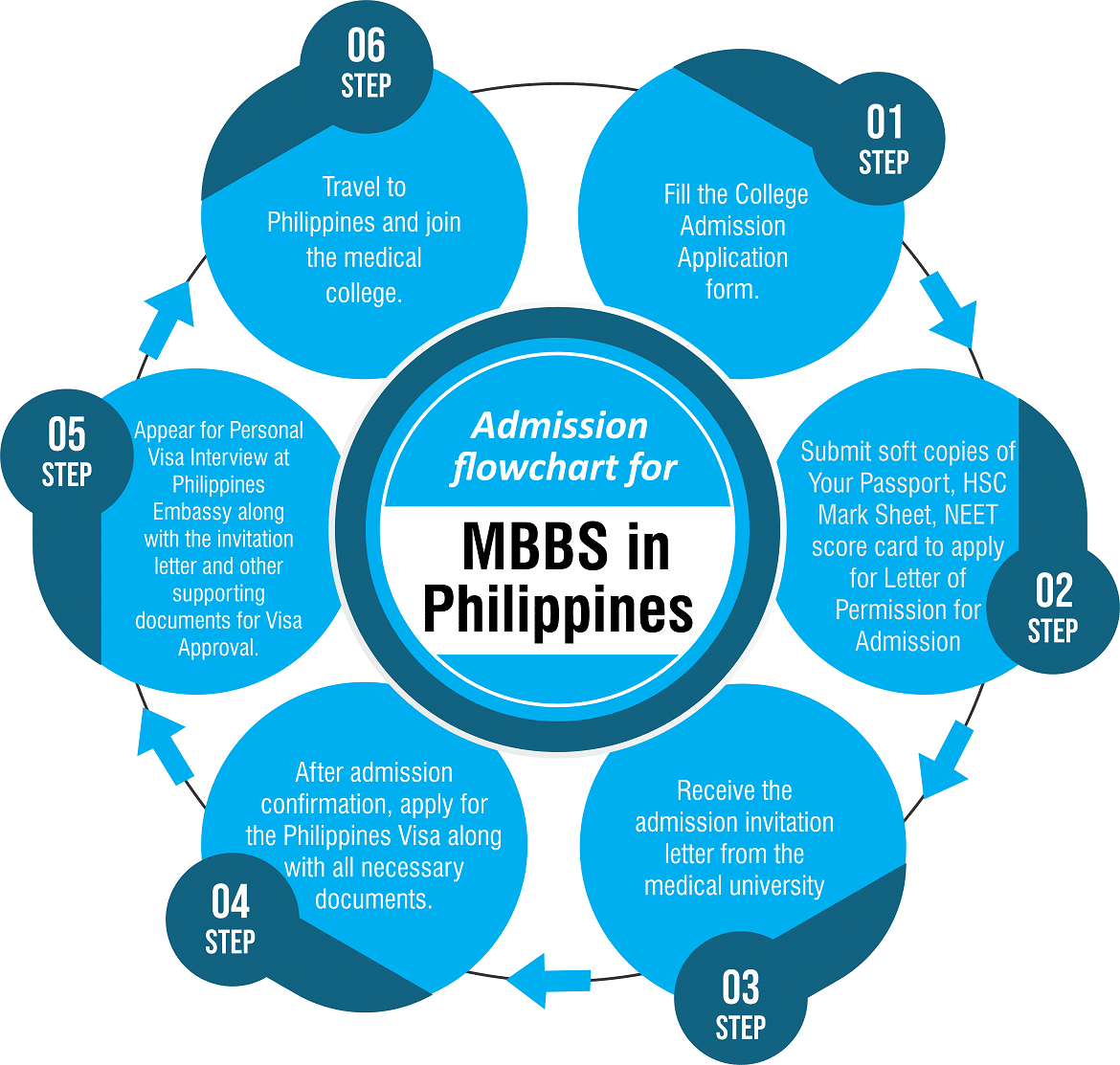
BS Program (Pre - Medicine Program) Syllabus (1.5 Years) in Philippines for Indian Students)
| Term | Course Name |
|---|---|
| 1st | Calculus and Analytical Geometry |
| Biochemistry | |
| Plant Morpho-Anatomy | |
| Comparative Vertebrate Anatomy | |
| General Physiology | |
| Parasitology | |
| Evolutionary Biology | |
| 2nd | Plant Physiology |
| Fundamentals of Genetics | |
| Animal Physiology | |
| Entomology Freshwater Biology | |
| General Microbiology | |
| Philosophy of Man | |
| Developmental Biology | |
| 3rd | Ecology |
| Education for Sustainable Development | |
| Research Methodology | |
| Systematic Biology | |
| Cell and Molecular Biology | |
| Comparative Religion | |
| Politics and Governance/Phil. Const | |
| 4th | Rizal’s Life Works and Writings |
| Econ/Taxation and Agrarian Reforms | |
| Human Genetics | |
| Radiation Biology | |
| Histology and Micro-technique | |
| Research in Bio. Sc. (Thesis writing) | |
| Immunology |
Syllabus of MBBS in Philippines for Indian Students
| Phase | Subjects | Focus |
|---|---|---|
| Pre-clinical years (1st and 2nd year) | Anatomy, Physiology, Biochemistry, Microbiology, Pathology, Pharmacology, and Behavioral Science | Building a strong foundation in basic medical sciences |
| Clinical years (3rd and 4th year) | Medicine, Surgery, Obstetrics and Gynecology, Pediatrics, Psychiatry, and Community Medicine | Developing clinical skills and practical experience |
| Internship (5th year) | Internal Medicine, Surgery, Obstetrics and Gynecology, Pediatrics, Community Medicine, Emergency Medicine, Radiology, Pathology, and Anesthesiology | Practical training in a clinical setting |
MBBS in Philippines v/s MBBS in India for Indian Students
| Criteria | MBBS in Philippines | MBBS in India |
|---|---|---|
| Duration of Course | 5.5 years | 5.5 years |
| Eligibility Criteria | 12th with PCB | 12th with PCB |
| Entrance Exam | NEET not required | NEET required |
| Medium of Instruction | English | English/Hindi |
| Cost of Education | High | Affordable |
| Quality of Education | Good | Varies |
| Recognition | MCI, WHO, ECFMG | MCI, WHO |
| Clinical Exposure | High | Moderate |
| Climate | Tropical | Varies |
| Accommodation | Affordable | Affordable |
| Language Barrier | Minimal | May exist |
| Job Opportunities | Good | Varies |
MBBS (Bachelor of Medicine and Bachelor of Surgery) is one of the most sought-after medical courses globally. Aspirants, who wish to pursue a career in medicine, have a tough time choosing between different countries for their MBBS degree. Two of the most common destinations for international students are the Philippines and India.
Here, we have compared MBBS in the Philippines and India based on different criteria:
Duration of Course: The duration of the MBBS course is the same in both countries, i.e., 5.5 years. It includes a 4-year academic program and a 1.5-year clinical rotation.
Eligibility Criteria: To be eligible for MBBS in the Philippines and India, the student should have completed their 12th with Physics, Chemistry, and Biology (PCB).
Entrance Exam: In India, NEET (National Eligibility cum Entrance Test) is mandatory for admission to MBBS courses. However, in the Philippines, NEET is not required.
Medium of Instruction: The medium of instruction in the Philippines is English, while in India, it is English or Hindi, depending on the university.
Cost of Education: Studying MBBS in the Philippines is relatively expensive as compared to India. However, the cost of education in the Philippines is still lower than other countries like the US, UK, or Australia.
Quality of Education: The quality of education in the Philippines is considered good. The Philippines has several medical schools with world-class facilities and excellent faculty. However, in India, the quality of education varies significantly depending on the college and university.
Recognition: The Medical Council of India (MCI) recognizes medical degrees from both the Philippines and India. In addition, the Philippines’ medical schools are also recognized by the World Health Organization (WHO) and the Educational Commission for Foreign Medical Graduates (ECFMG).
Clinical Exposure: The Philippines provides a high level of clinical exposure to its students, which is considered one of the best in the world. On the other hand, in India, the level of clinical exposure varies depending on the college and university.
Climate: The Philippines has a tropical climate, which can be a challenge for some students. However, India’s climate varies significantly depending on the region.
Accommodation: Accommodation in the Philippines is affordable and easily available for international students. The cost of accommodation in India varies depending on the city and region.
Language Barrier: In the Philippines, there is minimal language barrier as English is widely spoken. However, in India, students may face some language barrier depending on the region and university.
Job Opportunities: Job opportunities for MBBS graduates from the Philippines are good. Students can practice medicine in the Philippines, the US, Canada, and other countries. Similarly, in India, there are several job opportunities available for MBBS graduates, including government and private hospitals, clinics, and research institutions. However, the competition is high, and students need to clear the MCI screening test before practicing medicine in India.
Frequently Asked Questions (FAQs)
What is the duration of the MBBS program in the Philippines?
The MBBS program in the Philippines is generally a 5.5-year program, including one year of clinical rotation. The program is divided into two parts: the first 16 months of the program is dedicated to pre-medical courses and the remaining four years are for the core medical curriculum.
What is the medium of instruction in the Philippines?
English is the official language of instruction in the Philippines, and all medical schools use English as the medium of instruction.
What are the eligibility criteria for studying MBBS in the Philippines?
To be eligible for the MBBS program in the Philippines, Indian students must have completed their 12th standard or equivalent examination with Physics, Chemistry, Biology, and English as their main subjects. They must also have scored a minimum of 50% in their 12th standard exams.
What is the admission process for MBBS in the Philippines?
The admission process for MBBS in the Philippines is relatively straightforward. Indian students need to apply to the medical school of their choice and submit the required documents, including their academic transcripts and certificates, passport, and a medical certificate. Once the application is approved, the student will receive an admission letter, and they can apply for a student visa.
Is NEET required for studying MBBS in the Philippines?
Yes, Indian students are required to clear the National Eligibility cum Entrance Test (NEET) to be eligible for studying MBBS in the Philippines. The score obtained in NEET is valid for three years.
Are Indian students eligible for a scholarship for MBBS in the Philippines?
Yes, some medical schools in the Philippines offer scholarships to international students, including Indian students. The scholarship programs may cover tuition fees, accommodation, and living expenses. Students can check the websites of the respective medical schools to know more about scholarship opportunities.
What is the cost of studying MBBS in the Philippines for Indian students?
The cost of studying MBBS in the Philippines is relatively affordable compared to other countries. The tuition fees vary depending on the medical school, but on average, it can range from $2,500 to $4,000 per year. The cost of living in the Philippines is also reasonable, and students can expect to spend around $300 to $500 per month on accommodation, food, and transportation.
What are the job opportunities for Indian students after completing MBBS in the Philippines?
After completing MBBS in the Philippines, Indian students can take the Foreign Medical Graduate Examination (FMGE) in India to practice medicine. Alternatively, they can choose to pursue a post-graduation degree in the Philippines or in other countries.
Is the MBBS degree from the Philippines recognized in India?
Yes, the MBBS degree from the Philippines is recognized by the Medical Council of India (MCI). However, Indian students are required to clear the FMGE to practice medicine in India.
What are the challenges Indian students might face while studying in the Philippines?
Studying in a foreign country can be challenging, and Indian students may face some difficulties. Some of the challenges include adjusting to the cultural differences, adapting to the new academic system, and dealing with homesickness. However, many medical schools in the Philippines have a supportive community of international students, and students can always reach out to the student services office for assistance.
What is the quality of education in medical schools in the Philippines?
The quality of education in medical schools in the Philippines is generally good. The medical curriculum is modeled after the US medical education system and is taught in English. Many medical schools have well-equipped laboratories and facilities for hands-on training.
What is the climate like in the Philippines?
The climate in the Philippines is generally warm and tropical, with temperatures ranging from 25 to 32 degrees Celsius. Indian students may need to adjust to the humidity and rainfall, especially during the rainy season.
What is the culture like in the Philippines?
The Philippines has a diverse culture influenced by its history and geography. Filipinos are generally friendly and hospitable to foreigners, and Indian students may find it easy to adjust to the culture.
What are the safety concerns for Indian students studying in the Philippines?
While the Philippines is generally a safe country, Indian students should exercise caution and be aware of their surroundings, especially when traveling at night. It is also advisable to follow the safety guidelines provided by the medical school and to avoid traveling to areas with a high crime rate.
What are the extracurricular activities available for Indian students in the Philippines?
Many medical schools in the Philippines offer a range of extracurricular activities, including sports, music, and cultural clubs. Indian students can join these clubs to meet new people and engage in activities outside of their academic studies.
Can Indian students work while studying in the Philippines?
Indian students are allowed to work part-time while studying in the Philippines, provided they have a valid student visa. However, the medical school may have restrictions on the number of hours students can work per week.
What are the visa requirements for Indian students studying in the Philippines?
Indian students need to apply for a student visa to study in the Philippines. The visa application process requires the student to submit their passport, admission letter from the medical school, and other supporting documents.
How can Indian students get in touch with other Indian students in the Philippines?
Many medical schools in the Philippines have a community of Indian students, and Indian students can reach out to them through social media or student organizations. The Indian embassy in the Philippines can also provide assistance to Indian students.
What is the accommodation like for Indian students in the Philippines?
Many medical schools in the Philippines provide accommodation for international students, including Indian students. The accommodation can range from dormitories to apartments, and the cost may vary depending on the location and type of accommodation.
What is the food like in the Philippines?
Filipino cuisine is a mix of different flavors and influences. Some Indian students may find the food spicy and similar to Indian cuisine. However, many international restaurants and fast-food chains are also available in the Philippines.
Top Medical Universities of Philippines
Davao Medical School Foundation, Philippines
Davao Medical School Foundation (DMSF) is a leading medical education institution located in Davao City, Philippines. Established in 1976, DMSF has been providing high-quality medical education to students from all over the world for over four decades. The institution is accredited by the Commission on Higher Education (CHED) and the…
Brokenshire College School of Medicine Philippines
Brokenshire College School of Medicine is a prestigious and reputed institution located in Davao City, Philippines. It is one of the few medical schools in the country that is recognized by the World Health Organization (WHO) and the Commission on Higher Education (CHED). The school was established in 1946 and…
UV Gullas College of Medicine
UV Gullas College of Medicine is a premier medical school located in Cebu City, Philippines. It is one of the top-ranked medical schools in the country, with a long history of producing world-class doctors and medical professionals. The college was established in 1919 and has since been providing quality medical…
PLTCI Asia Pacific College of Medicine & Research
PLTCI Asia Pacific College of Medicine & Research is a premier medical institution located in the Philippines. Established in 2005, the college is dedicated to providing quality medical education and research opportunities to students from all over the world. The college has a team of highly qualified and experienced faculty…
The Manila Times College, School of Medicine Philippines
The Manila Times College, School of Medicine is a prestigious educational institution located in the heart of Manila, Philippines. The school is dedicated to providing high-quality medical education and training to aspiring physicians, equipping them with the knowledge and skills they need to succeed in their careers. The Manila Times…
Lyceum-Northwestern University
Lyceum Northwestern University (LNU) was established in 1969 in Dagupan City, a small city with a population of around 180,000 inhabitants in the province of Pangasinan on the island of Luzon. Originally named the Dagupan City School of Nursing, it started as a single-room nursing school at the Dagupan City…
Our Lady of Fatima University (OLFU), Philippines College of Medicine
Our Lady of Fatima University (OLFU) is a private Catholic university located in the Philippines. It was founded in 1967 by Dr. Vicente M. Santos and his wife, Dr. Juliet Olivares-Santos. The university is named after Our Lady of Fatima, the patroness of Valenzuela City, where the university's main campus…
University of Perpetual Help, Philippines
The University of Perpetual Help System DALTA (UPHSD) is a private university located in Las Piñas, Metro Manila, Philippines. It was founded in 1975 by Dr. Jose G. Tamayo and his wife, Dr. Josefina Laperal Tamayo, as Perpetual Help College of Rizal. Over the years, the institution has expanded and…
Southwestern University School of Medicine – Philippines
Southwestern University (SWU), officially known as Southwestern University PHINMA, is a privately-owned educational institution located in Cebu City, Philippines. The university was founded in 1946 by two pharmacists as Southwestern Colleges and was later renamed to Southwestern University on December 11, 1959, after being granted university status. In 2015, the…
Ago Medical and Educational Center Bicol Christian College of Medicine
Ago Medical and Educational Center Bicol Christian College of Medicine, located in Legazpi City, is widely considered as one of the top Colleges in the Philippines for pursuing an MBBS degree. The institution was established in 1975 by Dr. Damaceno J. Ago, and it has since become renowned for its…
Cagayan State University College of Medicine
Cagayan State University (CSU) is a public university located in Tuguegarao City, Cagayan, Philippines. Established in 1978, CSU has grown to become one of the leading universities in Northern Luzon, offering a wide range of undergraduate and graduate programs in various fields of study. The university is composed of eight…
Cebu Doctors University Philippines
Cebu Doctors' University, which is commonly known as CDU or Cebu Doc, is a private, non-religious, coeducational institution of higher learning situated in Mandaue City, Cebu, Philippines. The school was founded in 1973 as Cebu Doctors' College (CDC) in Cebu City and was later renamed Cebu Doctors' University (CDU) in…
Compare Universities
| University Name | Established Year | Eligibility | NEET Score | Tuition Fee | Hostel Fees | Population | Country Rank | World Rank | Location | REMARKS |
| AMA School of Medicine | 2004 | HSC QUALIFIED | NEET QUALIFIED | 3500 USD | 2000 USD | 5,83,000 | NA | NA | Makati | |
| Angeles University Foundation | 1962 | HSC QUALIFIED | NEET QUALIFIED | 4500 USD | 750 USD | 4,12,000 | 29 | 7599 | Angeles City | |
| Ateneo de Zamboanga University | 1912 | 85% IN HSC | NEET QUALIFIED | NA | NA | 8,62,000 | 128 | 11022 | Zamboanga City | |
| Baguio Central University | 2003 | HSC QUALIFIED | NEET QUALIFIED | NA | NA | NA | NA | NA | NA | CLOSED IN 2013 |
| BICOL CHRISTIAN COLLEGE OF MEDICINE | 1980 | HSC QUALIFIED | NEET QUALIFIED | 3000 USD | 1100 USD | 1,82,000 | 84 | 9837 | Legazpi City | |
| Cagayan State University Tuguegarao (Carig) | 1978 | HSC QUALIFIED | NEET QUALIFIED | 3500 USD | 1100 USD | 1,39,000 | 108 | 10471 | Tuguegarao City | |
| Cebu Doctors University College of Medicine | 1973 | HSC QUALIFIED | NEET QUALIFIED | 6600 USD | 1200 USD | 3,63,000 | 100 | 10278 | Mandaue City | |
| Cebu Institute of Medicine | 1957 | HSC QUALIFIED | NEET QUALIFIED | 5000 USD | 1200 USD | 9,23,000 | 192 | 12104 | Cebu City | |
| Central Philippine University | 1905 | HSC QUALIFIED | NEET QUALIFIED | NA | NA | 4,48,000 | 24 | 7148 | Iloilo City | |
| Davao Medical School Foundation | 1975 | HSC QUALIFIED | NEET QUALIFIED | 4700 USD | 1200 USD | 16,03,000 | 159 | 11619 | Davao City | |
| De La Salie University Health Sciences Campus | 1979 | HSC QUALIFIED | NEET QUALIFIED | 5500 USD | 1500 USD | 5,76,000 | 62 | 9052 | Dasmariñas City | |
| Dona Remedos Trinidad Medical Foundation | 1980 | HSC QUALIFIED | NEET QUALIFIED | NA | NA | 2,42,000 | NA | NA | Tacloban | |
| Emilo Aguinaldo College, Manila | 1973 | HSC QUALIFIED | NEET QUALIFIED | 4800 USD | 1500 USD | 17,80,000 | 53 | 8888 | Manila | |
| Far Eastern University Dr. Nicanor Reyes Medical Foundation | 1928 | HSC QUALIFIED | NEET QUALIFIED | NA | NA | 17,80,000 | 57 | 8962 | Manila | |
| Iloilo Doctors College of Medicine | 1981 | HSC QUALIFIED | NEET QUALIFIED | 3500 USD | 1500 USD | 4,48,000 | NA | NA | Iloilo City | |
| Lyceum Northwestern University / Dr. Francisco Q. Duque Medical Foundation College of Medicine | 1975 | HSC QUALIFIED | NEET QUALIFIED | 3500 USD | 1500 USD | 17,80,000 | 91 | 10005 | Manila | |
| Manila Central University | 1904 | HSC QUALIFIED | NEET QUALIFIED | 8100 USD | 1500 USD | 1,583,978 | 48 | 8695 | Caloocan | |
| Our Lady of Fatima University (Fatima Medical Science Foundation) Valenzuela | 1967 | HSC QUALIFIED | NEET QUALIFIED | 5500 USD | 1500 USD | 6,20,000 | 44 | 8507 | Valenzuela City | |
| Pamantasan ng Lungsod ng Maynila | 1965 | HSC QUALIFIED | NEET QUALIFIED | 2800 USD | 1200 USD | 17,80,000 | 46 | 8652 | Manila | |
| Saint Louis University | 1965 | HSC QUALIFIED | NEET QUALIFIED | NA | NA | 1,39,000 | 112 | 10623 | Tuguegarao City | |
| San Beda College | 1901 | HSC QUALIFIED | NEET QUALIFIED | 5200 USD | 1200 USD | 17,80,000 | 78 | 9602 | Manila | |
| Silliman University | 1901 | HSC QUALIFIED | NEET QUALIFIED | 2000 USD | 1500 USD | 1,21,000 | 8 | 5372 | Dumaguete City | |
| Southwestern University Matias H. Aznar Memorial College of Medicine | 2015 | HSC QUALIFIED | NEET QUALIFIED | 2800 USD | 1500 USD | 9,23,000 | NA | NA | Cebu City | |
| Southwestern University, Urgello, Cebu City, Philippines | 1946 | HSC QUALIFIED | NEET QUALIFIED | NA | NA | 9,23,000 | 76 | 9450 | Cebu City | |
| St. Lukes College of Medicine William H. Quasha Memorial | 1993 | HSC QUALIFIED | NEET QUALIFIED | 4500 USD | 1500 USD | 29,04,000 | 148 | 11341 | Quezon City ( | |
| St. Paul University,Philippines | 1912 | HSC QUALIFIED | NEET QUALIFIED | NA | NA | 17,80,000 | 115 | 10724 | Manila | |
| University of Northern Philippines | 1906 | HSC QUALIFIED | NEET QUALIFIED | 2800 USD | 1200 USD | 53,879 | 105 | 10362 | Vigan City | |
| University of Perpetual Help Rizal | 1976 | HSC QUALIFIED | NEET QUALIFIED | 5300 USD | 1200 USD | 2,83,000 | 149 | 11344 | City of Biñan | |
| University of Saint La Salle | 1952 | HSC QUALIFIED | NEET QUALIFIED | 3500 USD | 1200 USD | 5,62,000 | 65 | 9158 | Bacolod City | |
| University of Santo Tomas | 1611 | HSC QUALIFIED | NEET QUALIFIED | 4200 USD | 1200 USD | 17,80,000 | 3 | 2588 | Manila | |
| University of the East Ramon Magsaysay Memorial Medical Center | 1956 | HSC QUALIFIED | NEET QUALIFIED | NA | NA | 29,04,000 | 75 | 9445 | Quezon City ( | |
| University of the Philippines Manila | 1908 | HSC QUALIFIED | NEET QUALIFIED | 1500 USD | 1200 USD | 17,80,000 | 7 | 5201 | Manila | |
| UV Gullas College of Medicine | 1919 | HSC QUALIFIED | NEET QUALIFIED | 4000 USD | 1500 USD | 9,23,000 | 137 | 11176 | Cebu City | |
| Virgen Milagrosa University Foundation | 1958 | HSC QUALIFIED | NEET QUALIFIED | 4000 USD | 1200 USD | 1,75,000 | 126 | 11004 | San Carlos City | |
| West Visayas State University | 1902 | HSC QUALIFIED | NEET QUALIFIED | 1000 USD | 1200 USD | 4,48,000 | 68 | 9240 | Iloilo City | |
| Xavier University | 1933 | HSC QUALIFIED | NEET QUALIFIED | 3000 USD | 1500 USD | 6,76,000 | 21 | 7069 | Cagayan de Oro City | |
| Zamboanga Medical School Foundation | 1912 | HSC QUALIFIED | NEET QUALIFIED | NA | NA | 8,62,000 | 128 | 11022 | Zamboanga City |


